Templates
The Webex Engage application enables the client admins to configure and manage new templates and template groups. The templates can be organized into groups for easier access and management. These templates can be shared across various teams.

Note:
The templates created by a client admin cannot be modified or deleted by a team or group admin.
To navigate to templates:
- Go to Admin Console > Assets > Templates.
- Template screen appears. An admin can create new groups and add templates under those groups.
The following template details are displayed:
- ID: Refers template name.
- Channel: Refers to the message channel (SMS/Facebook/Apple Business Chat/LiveChat/Twitter/WhatsApp/Email/API) of the agent throughout the chat.
- Template: Refers to the customized message with the variables in tags.
- Start Template: Refers to the first message to initiate the chat conversation.
- Followup Template: Refers to the standard message that can be used to follow-up the chat conversation.
- End Template: Refers to the last message of the chat conversation.
- Actions: Refers to the activities that can be performed on the template (i.e.) Edit and Delete.
In the Templates page, the client admin can,
- Upload Templates
- Create New Template Group
- Delete Template Group
- Add New Template
- Edit Template
- Delete Template
Detailed information on each of the feature is provided in the subsequent sections.
Upload Templates
Upload templates functionality helps to bulk upload templates at once by reducing the time taken to create templates.
To upload templates, follow these steps:
- Click Upload Template on the top-right corner of the templates screen.
The following page appears on the screen.

- Click Download sample file here link.
A sample file is downloaded. - Open the sample file and enter following details in the respective cells:
Note
- All fields in the sample file are mandatory.
- Do not edit or change the column header names and ensure that the team names are comma-separated in the shared across TeamNames column.
Channel: Enter the name of the channel such as, All, SMS, Email, Facebook, Twitter, Livechat, API, Apple Business Chat, or WhatsApp.
TemplateGroup: Enter the name of the template group.
TemplateName: Enter the name of the template.
Text: Compose the template text as per the configured character limit for each channel template on the Webex Engage application.
Locked: Enter Yes to lock the template, or No to keep it unlocked.
TemplateNames: Enter the team names as comma-separated values. More than one team name means that the templates are shared across the configured teams.
- Delete the help notes in the .csv file before uploading it.
- Save the file.
- Click Upload File.
Upload the file only in the .csv format.
Note
- The upload templates file name must be unique.
- The file size must not exceed 5 MB, and it accommodates a maximum of 1000 templates per upload.
- Text Template column supports all the Unicode characters.
- Use the Pipe symbol (|) as a delimiter to enter multiline text in the Text column.
- In the upload templates file, even If a single template text record ends with a delimiter-pipe symbol (|), all the records in that file must end with the same delimiter.
- Click Track Upload Status on the top-right corner of the Upload Templates screen to view the status of the files that you uploaded.
You will navigate to the following screen.
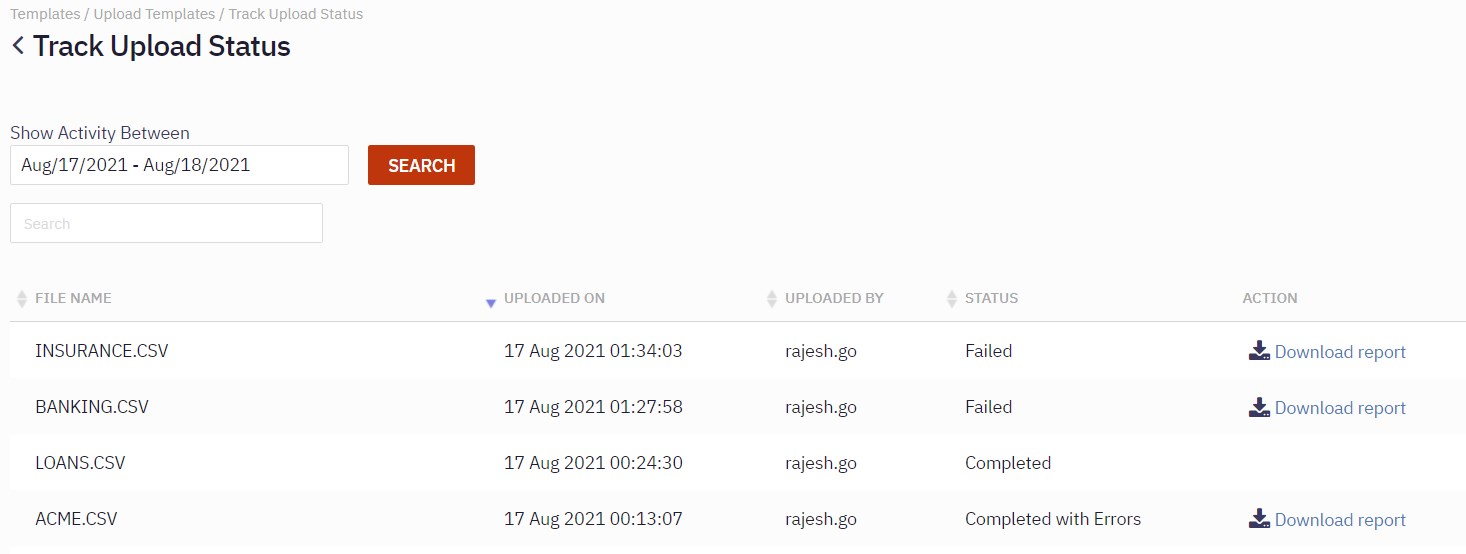
- In the Show Activity Date Range filed, select a date range and click Apply.
- Click Search.
The relevant search results will appear on the screen. - Optionally, enter a file name in the Search field to filter the table results.
The Status column shows the status of the uploaded file as Completed, Completed with errors, or Failed. - If the uploaded file fails the validation or gets uploaded with errors, you will view a report in the Actions column.
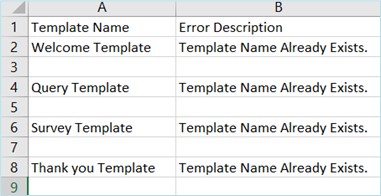
- Click the Download Report in the Actions column.
- Fix the errors in the file, based on the report's findings.
- Return to Step 6 to upload the file again.
Create New Template Group
To create new template group, follow these steps:
- Click Add icon adjacent to the Template Groups. The Add Template Group pop-up window appears.

- Enter Group Name and click Add.
The success message appears on the screen.
Delete Template Group
- Click Delete icon adjacent to the template group name that needs to be deleted.
A confirmation pop-up window is displayed.

- Click OK .
The success message appears on the screen.
Add New Template
This feature enables the client admins to add message template formats for each channel.
Follow these steps to create templates:
- Click Add Template button on the top-right-corner of the templates screen.
The client admin can create the templates for all channels or any of the following channels:
- SMS
- Livechat
- API
- Apple Business Chat
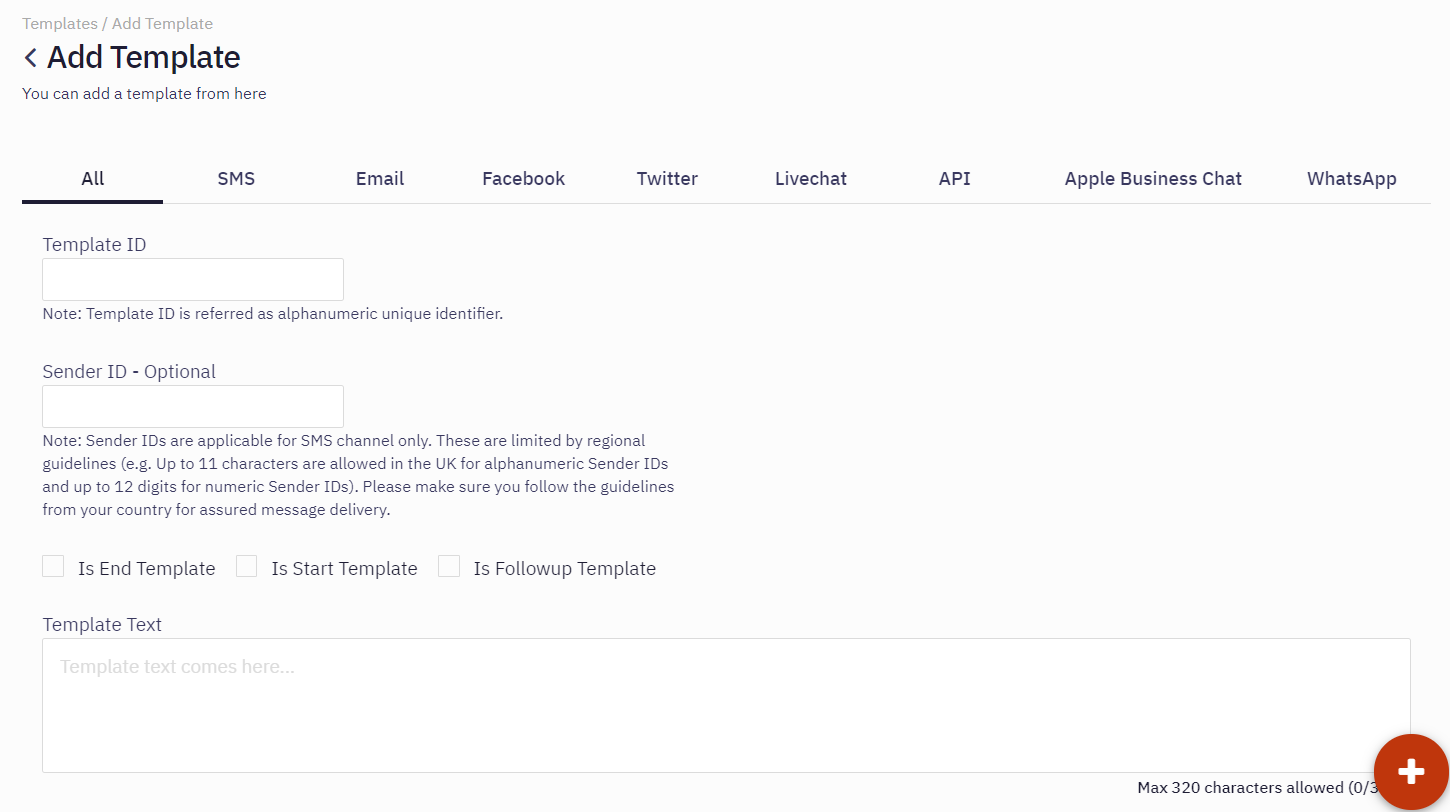
SMS Template
To create an SMS template (or All Channels template), follow these steps:
- Click All or SMS tab .
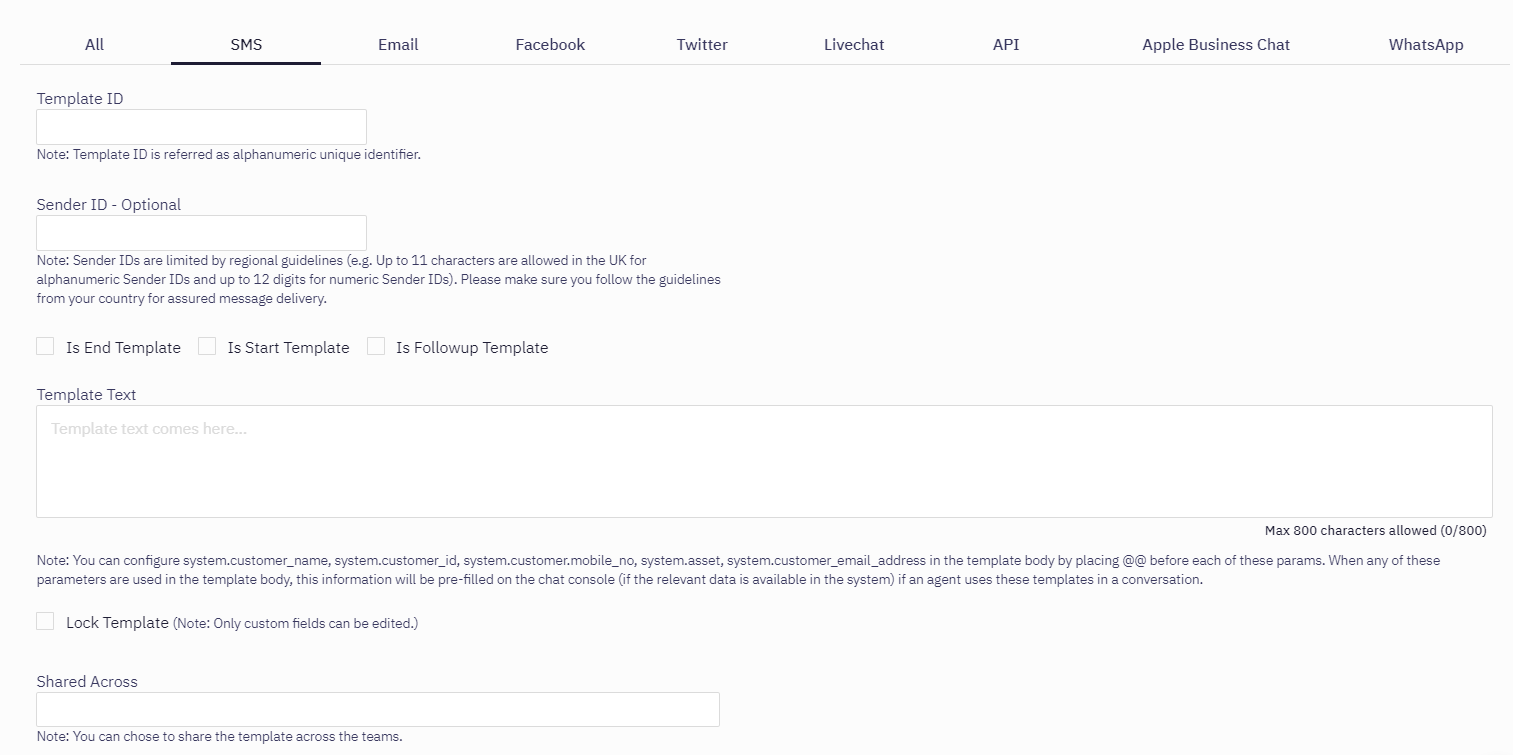
- Enter a Template Name in the Template ID field.
Note
The default Sender ID (short code assigned to the team if SMS is enabled as a Channel) is loaded automatically while creating a template. This feature allows the client admin to easily create and keep track of the templates.
- Select the Is End template checkbox to set the template as a closing message of the chat conversation.
For example: Thank you for your time. The agents will not expect any response to this message from the customer. - Select the Is Start template checkbox to set the template as an opening message to initiate the chat conversation.
For example: Hello. - Select the Is Followup template checkbox to set the template as follow-up message of the previous chat conversation.
For example: In line with our earlier chat. - Custom Fields: Enter custom/editable fields in the template body using chevron(<>) brackets. Custom fields are editable fields even in locked templates.
- System Parameters: Enter @@ to view the list of system parameters. You can select any of these parameters and compose the template text. When you include any of these parameters in the template text, the dynamic substitution of values occurs when an agent uses these templates in a conversation.


Note:
In the absence of relevant values for the configured parameters, the parameters will render in chevron braces and are yellow highlighted.
- You can choose to enter the customized Template Text field. Maximum of 800 characters can be entered in the text box.
- Select Lock Template checkbox to lock specific templates. When locked, only custom/dynamic fields can be edited by the agents. A lock icon is displayed corresponding to the template. Refer the image below.

- To share the template with other teams, click in the Shared Across box and select the team from the list.
- Click Save Changes.
The success message appears on the screen.
Email Template
To create an Email template, follow these steps:
- Click Email tab.
The following screen appears.
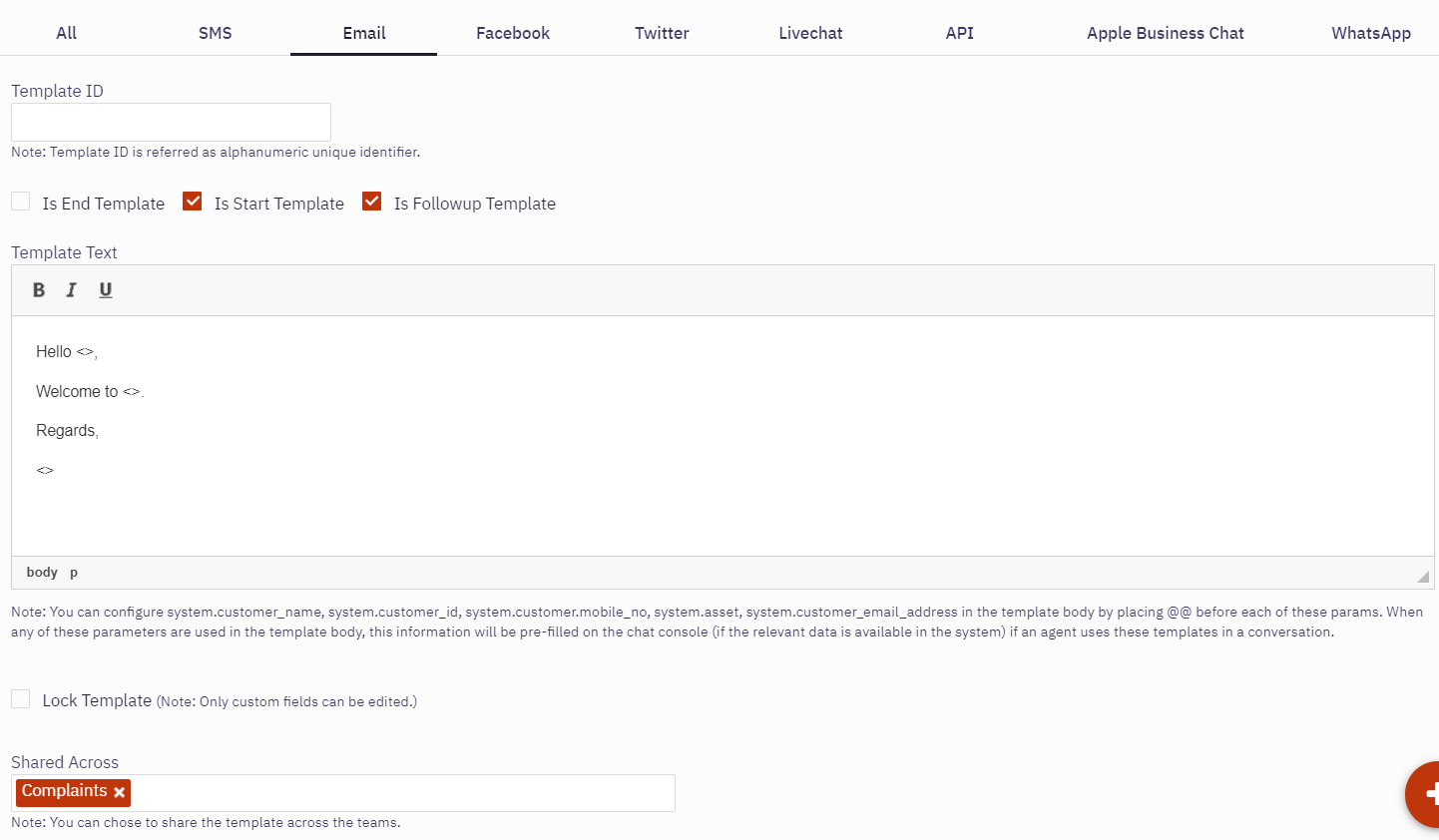
- Enter a Template Name.
- Select the Is end template checkbox to set the template as a closing message of the chat conversation.
For example: Thank you for your time. The agents will not expect any response to this message from the customer. - Select the Is start template checkbox to set the template as an opening message to initiate the chat conversation.
For example: Hello.
5 Select the Is Followup template checkbox to set the template as follow-up chat message of the previous chat conversation.
For example: In line with our earlier chat. - Compose the Template Text.
- Custom Fields: Enter custom/editable fields in the template body using chevron(<>) brackets. Custom fields are editable fields even in locked templates.
- System Parameters: Enter @@ to view the list of system parameters. You can select any of these parameters and compose the template text. When you include any of these parameters in the template text, the dynamic substitution of values occurs when an agent uses these templates in a conversation.

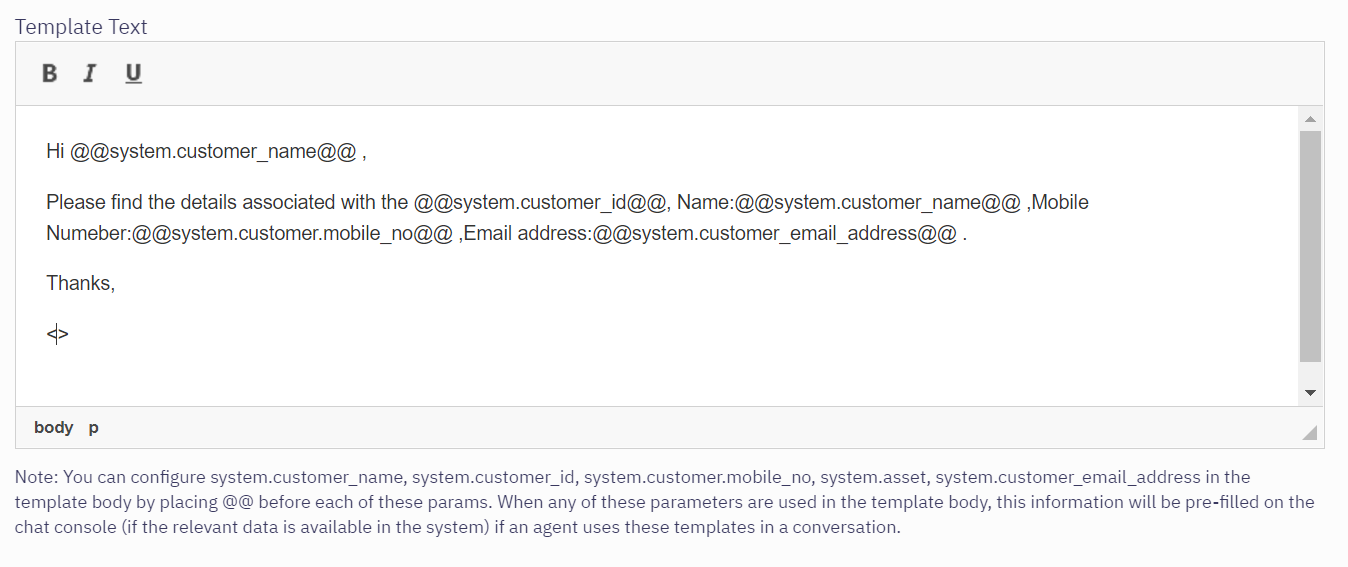
Note:
In the absence of relevant values for the configured parameters, the parameters will render in chevron braces and are yellow highlighted.
- You can even choose to enter the customized message in the text box.
- Select Lock Template checkbox to lock specific templates. When locked, only custom/dynamic fields can be edited by the agents. A lock icon is displayed corresponding to the template.
- To share the template with other teams, click in the Shared Across box and select the team from the list.
- Click Save Changes.
The success message is displayed on the screen.
Facebook Template
To create a Facebook template, follow these steps:
- Click Facebook tab. The following screen appears.

An admin can create Plain Text, Action, and Multimedia templates.
2. Enter a Template Name for the template in the Template ID field.
3. Select the Is end template checkbox to set the template as a closing message of the chat conversation.
For example: Thank you for your time. The agents will not expect any response to this message from the customer.
4. Select the Is start template checkbox to set the template as an opening message to initiate the chat conversation.
For example: Hello.
5. Select the Is Followup template checkbox to set the template as follow-up message of the previous chat conversation.
For example: In line with our earlier chat.
6. The Text Template radio button is selected by default.
7. Custom Fields: Enter custom/editable fields in the template body using chevron(<>) brackets. Custom fields are editable fields even in locked templates.
8. System Parameters: Enter @@ to view the list of system parameters. You can select any of these parameters and compose the template text. When you include any of these parameters in the template text, the dynamic substitution of values occurs when an agent uses these templates in a conversation.
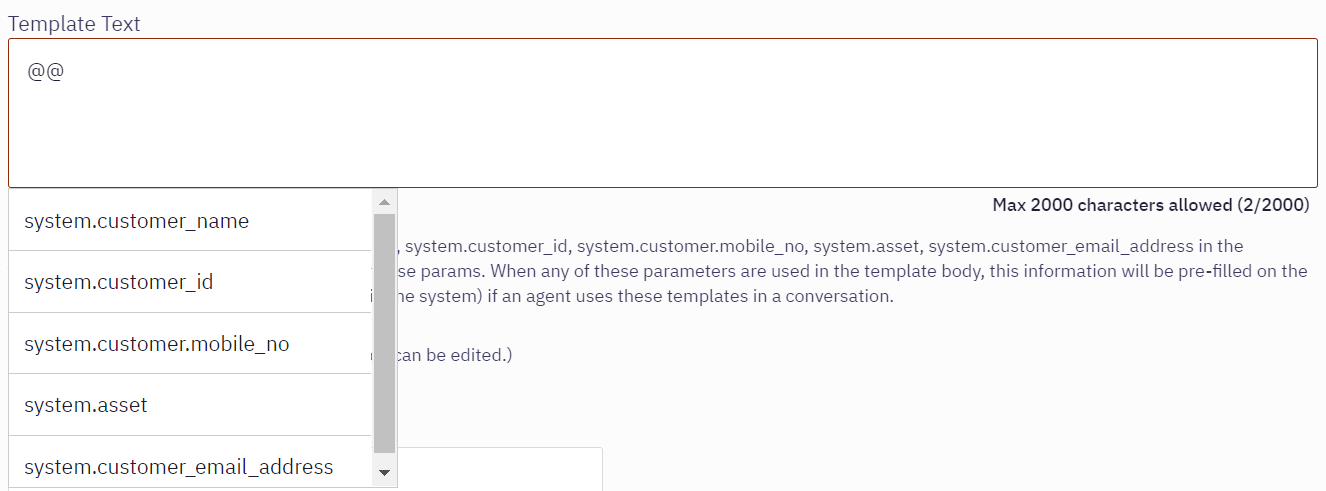

Note:
In the absence of relevant values for the configured parameters, the parameters will render in chevron braces and are yellow highlighted.
- You can even choose to enter the customized template text and click Save Changes.
- To create an Action Template, select the Action Template radio button. This option is used when a quick response is expected from the customer. The message is sent with image and buttons, wherein the customer can respond with a click of a button.
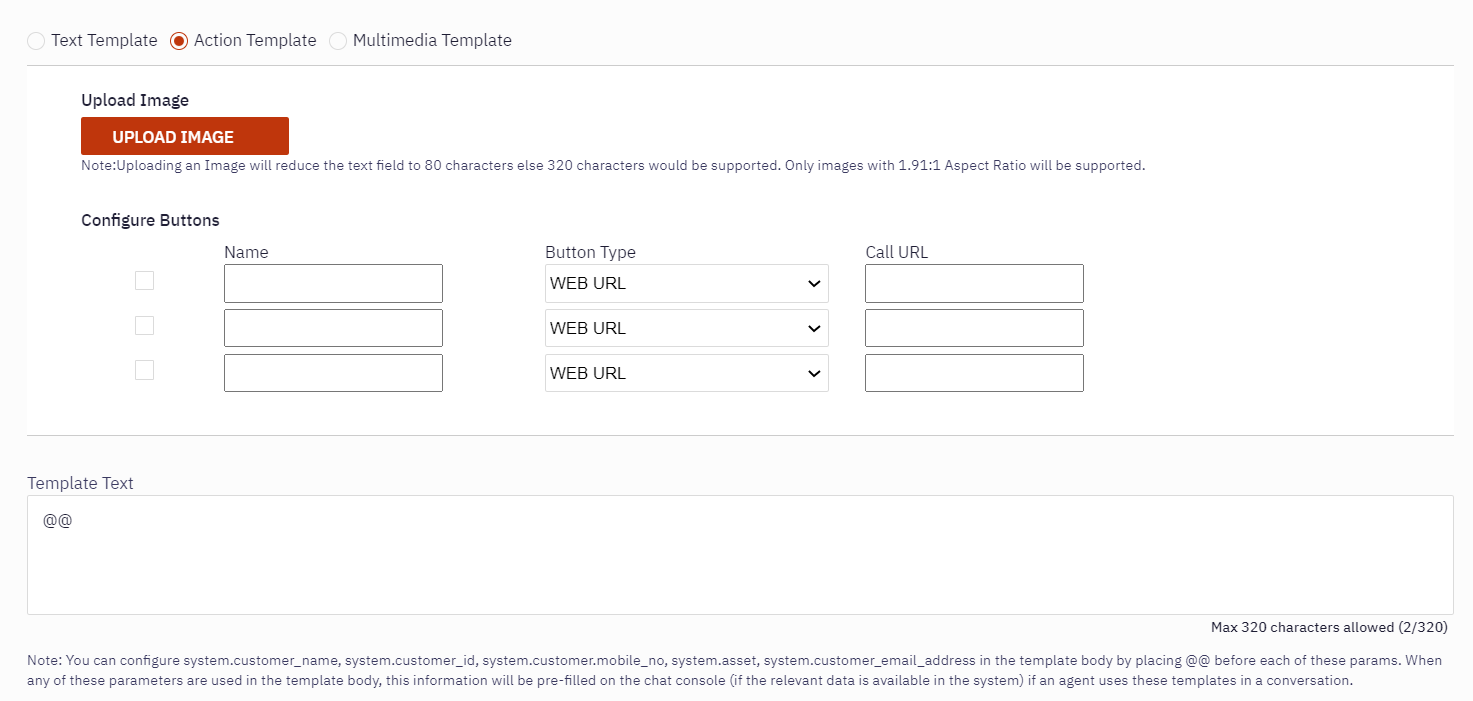
- Click Upload Image to browse and select the required image.
Note
- The Webex Engage supports images with an aspect ratio of 1.91:1 only.
- Enter Button Names and select Button Type from the drop-down list.
- If WEB URL button type is chosen, then enter the Call URL.
- Compose the Template Text.
- To create a Multimedia template, select the Multimedia Template radio button. The multimedia types supported are as follows:
- Image
- Audio
- Video
- File
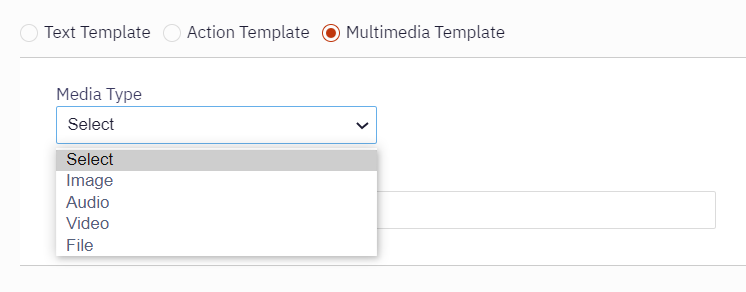
- Select the type of media in Media Type field and enter the respective downloadable URL in Enter Media URL field.
- Select Lock Template checkbox to lock specific templates. When locked, only custom/dynamic fields can be edited by the agents. A lock icon is displayed corresponding to the template.
- To share the template with other teams, click in the Shared Across box and select the team from the list.
- Click Save Changes to create the template. The success message appears on the screen.
The newly added templates will be displayed under the selected template group.
Twitter Template
To create a Twitter template, follow these steps:
- Click the Twitter tab on the add template page.
The following screen appears.
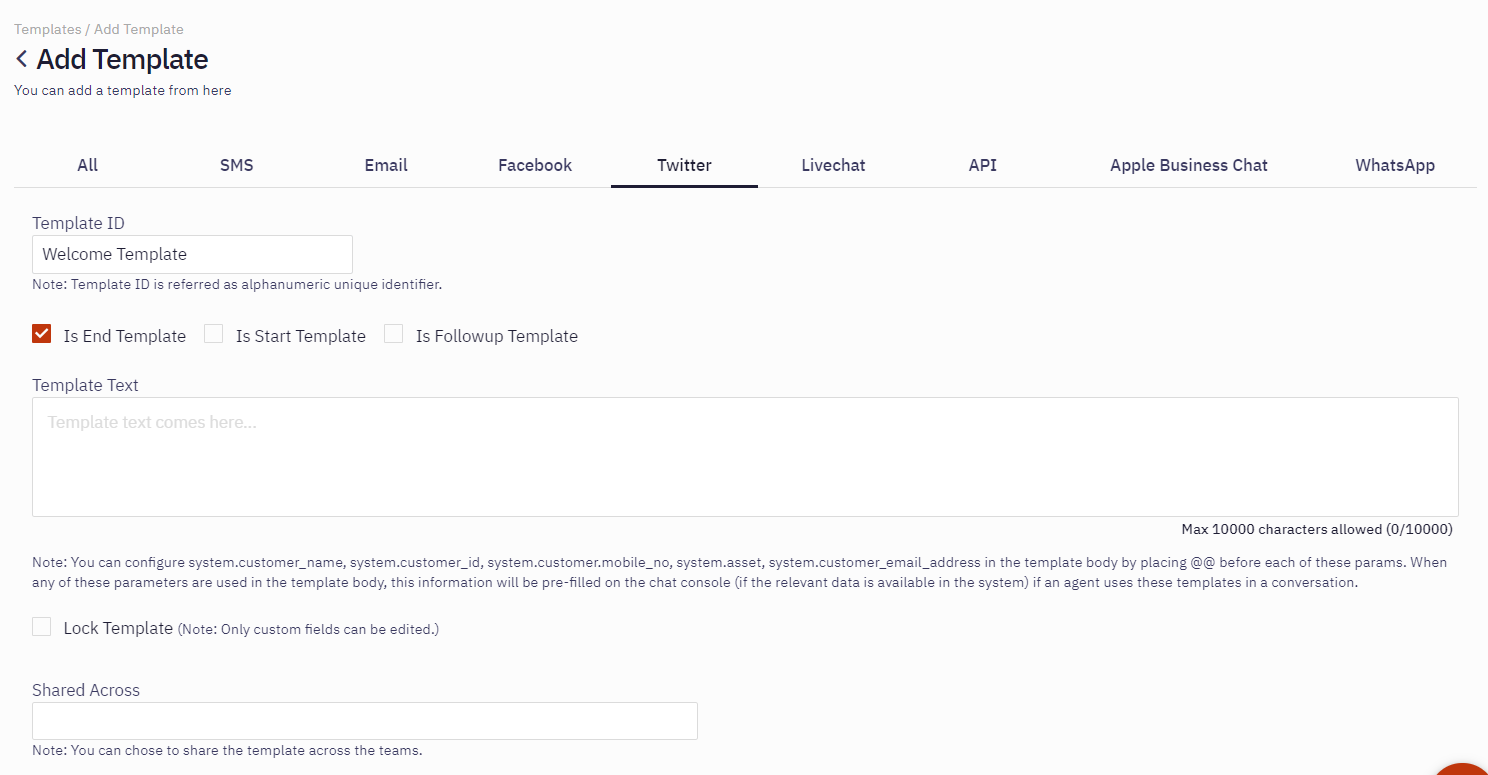
- Enter a Template Name for the template in the Template ID field.
- Select the Is end template checkbox to set the template as a closing message of the chat conversation.
For example: Thank you for your time. The agents will not expect any response to this message from the customer. - Select the Is start template checkbox to set the template as an opening message to initiate the chat conversation.
For example: Hello. - Select the Is Followup template checkbox to set the template as follow-up message of the previous chat conversation.
For example: In line with our earlier chat. - Custom Fields: Enter custom/editable fields in the template body using chevron(<>) brackets. Custom fields are editable fields even in locked templates.
- System Parameters: Enter @@ to view the list of system parameters. You can select any of these parameters and compose the template text. When you include any of these parameters in the template text, the dynamic substitution of values occurs when an agent uses these templates in a conversation.
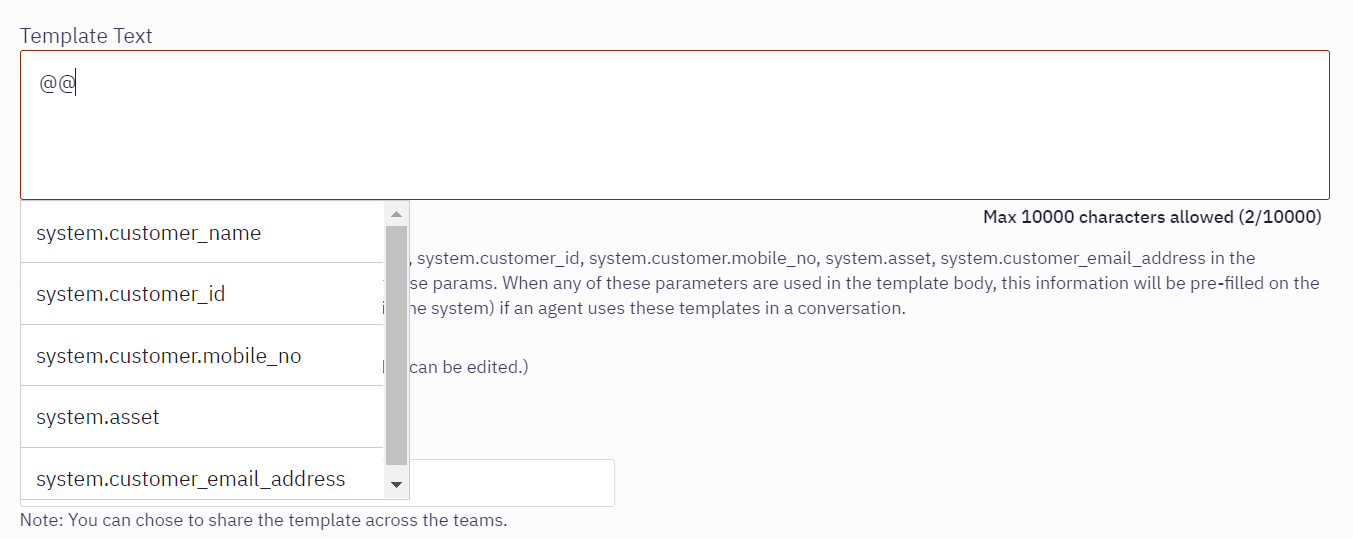

Note:
In the absence of relevant values for the configured parameters, the parameters will render in chevron braces and are yellow highlighted.
- You can even choose to enter the customized Template Text.
- Select Lock Template checkbox to lock specific templates. When locked, only custom/dynamic fields can be edited by the agents. A lock icon is displayed corresponding to the template.
- To share the template with other teams, click in the Shared Across field and select the team from the list.
- Click Save Changes to create the template.
The success message appears on the screen.
Livechat Template
To create a Livechat template, follow these steps:
- Click the Livechat tab on the Add Template page.
The following screen appears.
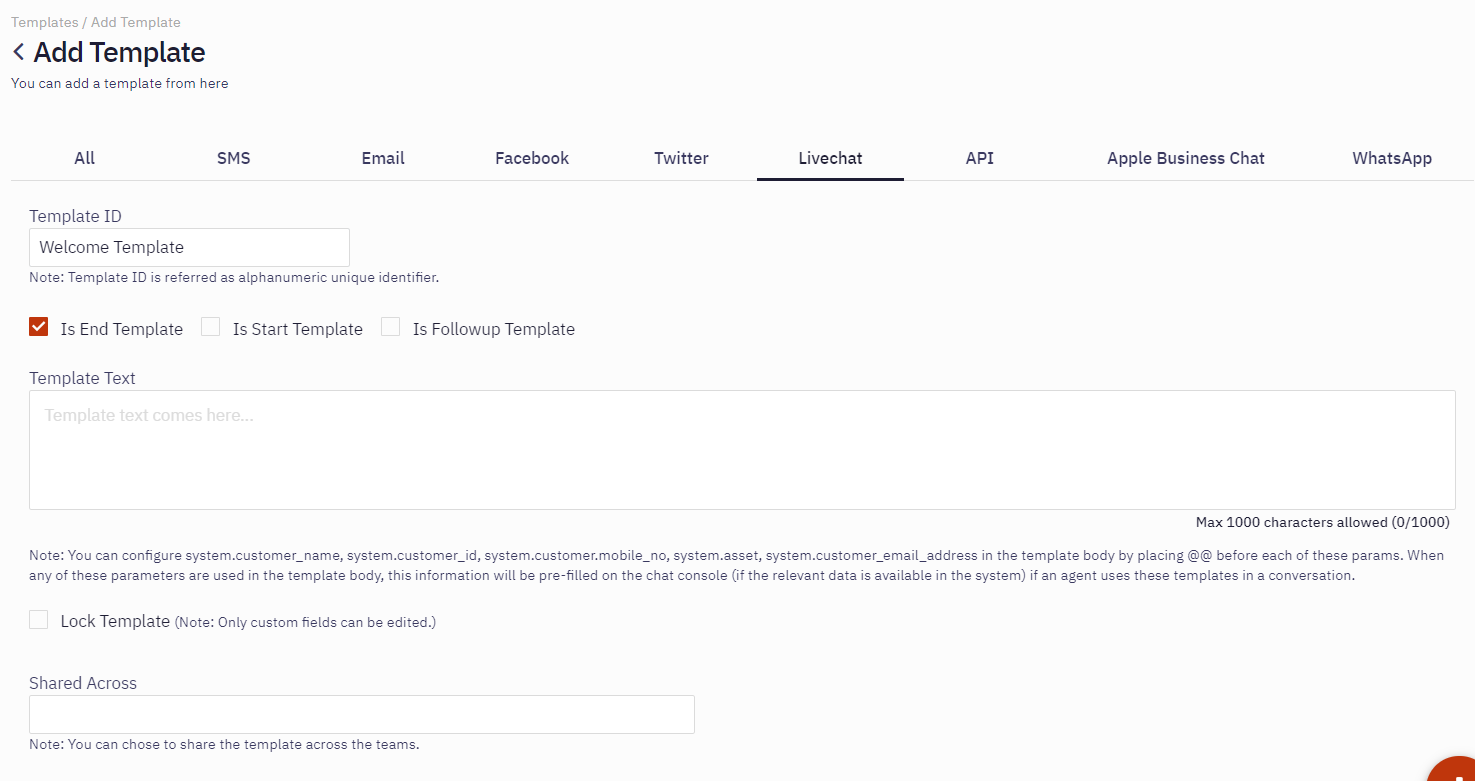
- Enter a Template Name for the template in the Template ID field.
- Select the Is end template checkbox to set the template as a closing message of the chat conversation.
For example: Thank you for your time. The agents will not expect any response to this message from the customer. - Select the Is start template checkbox to set the template as an opening message to initiate the chat conversation.
For example: Hello. - Select the Is Followup template checkbox to set the template as follow-up message of the previous chat conversation.
For example: In line with our earlier chat. - Custom Fields: Enter custom/editable fields in the template body using chevron(<>) brackets. Custom fields are editable fields even in locked templates.
- System Parameters: Enter @@ to view the list of system parameters. You can select any of these parameters and compose the template text. When you include any of these parameters in the template text, the dynamic substitution of values occurs when an agent uses these templates in a conversation.
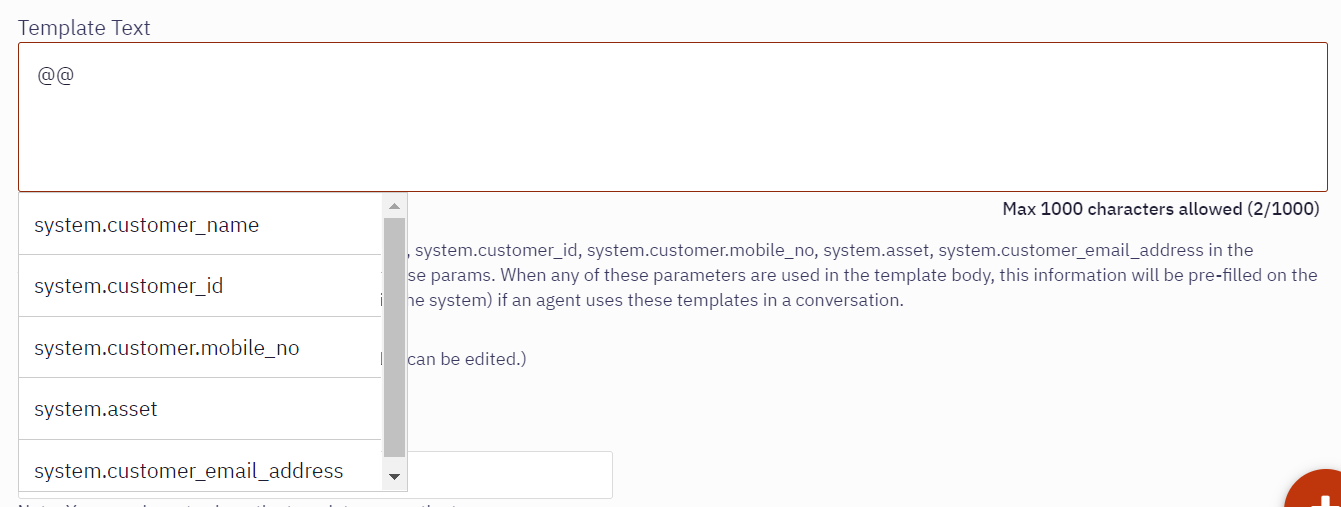
- You can even choose to enter the customized Template Text field.

Note:
In the absence of relevant values for the configured parameters, the parameters will render in chevron braces and are yellow highlighted.
- Select Lock Template checkbox to lock specific templates. When locked, only custom/dynamic fields can be edited by the agents. A lock icon is displayed corresponding to the template.
- To share the template with other teams, click in the Shared Across field and select the team from the list.
- Click Save Changes to create the template.
The success message appears on the screen.
API Template
To create an API template, follow these steps:
- Click API tab on the Add Template page.
The following screen appears.
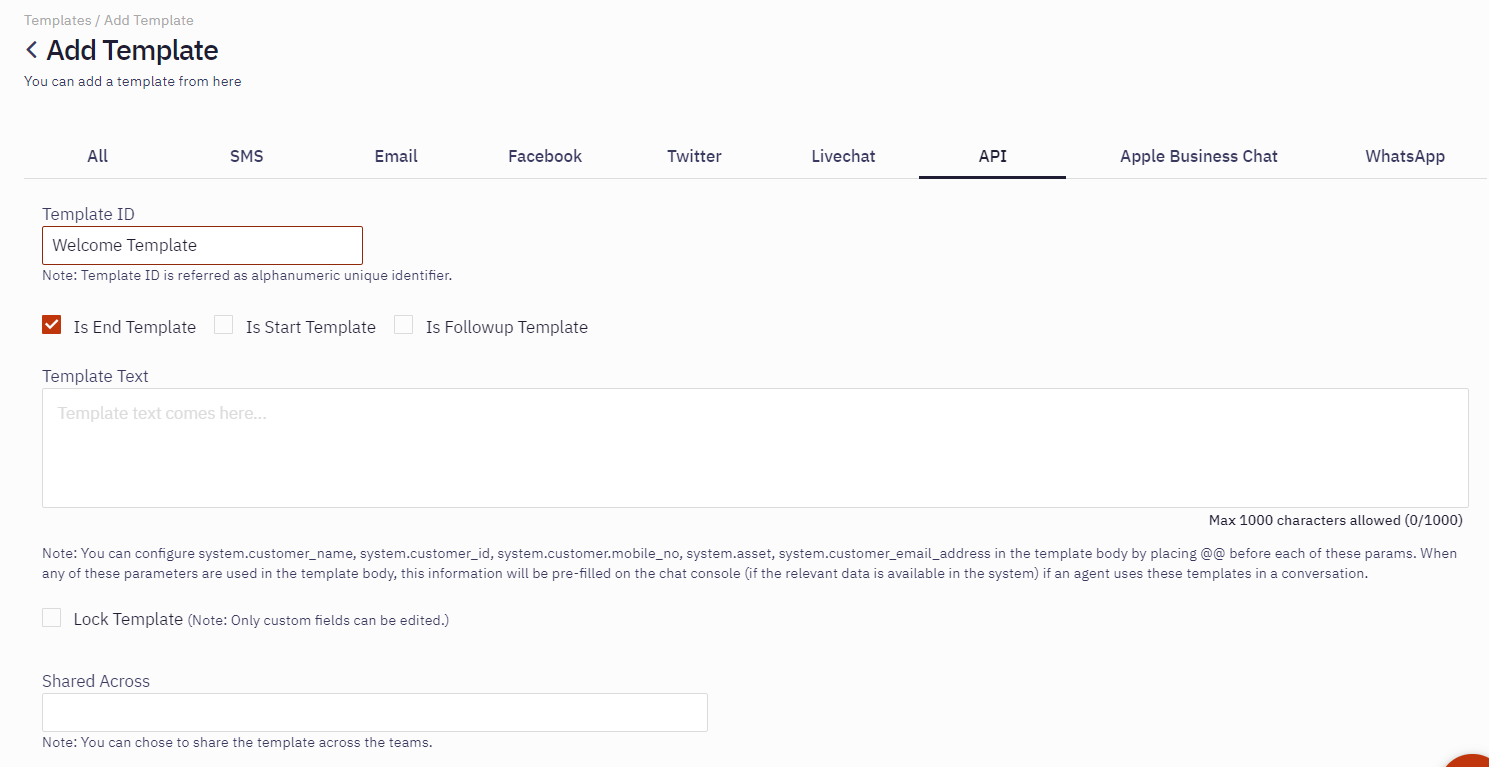
- Enter a Template Name for the template in the Template ID field.
- Select the Is end template checkbox to set the template as a closing message of the chat conversation.
For example: Thank you for your time. The agents will not expect any response to this message from the customer. - Select the Is start template checkbox to set the template as an opening message to initiate the chat conversation.
For example: Hello. - Select the Is Followup template checkbox to set the template as follow-up chat message of the previous chat conversation.
For example: In line with our earlier chat. - Custom Fields: Enter custom/editable fields in the template body using chevron(<>) brackets. Custom fields are editable fields even in locked templates.
- System Parameters: Enter @@ to view the list of system parameters. You can select any of these parameters and compose the template text. When you include any of these parameters in the template text, the dynamic substitution of values occurs when an agent uses these templates in a conversation.
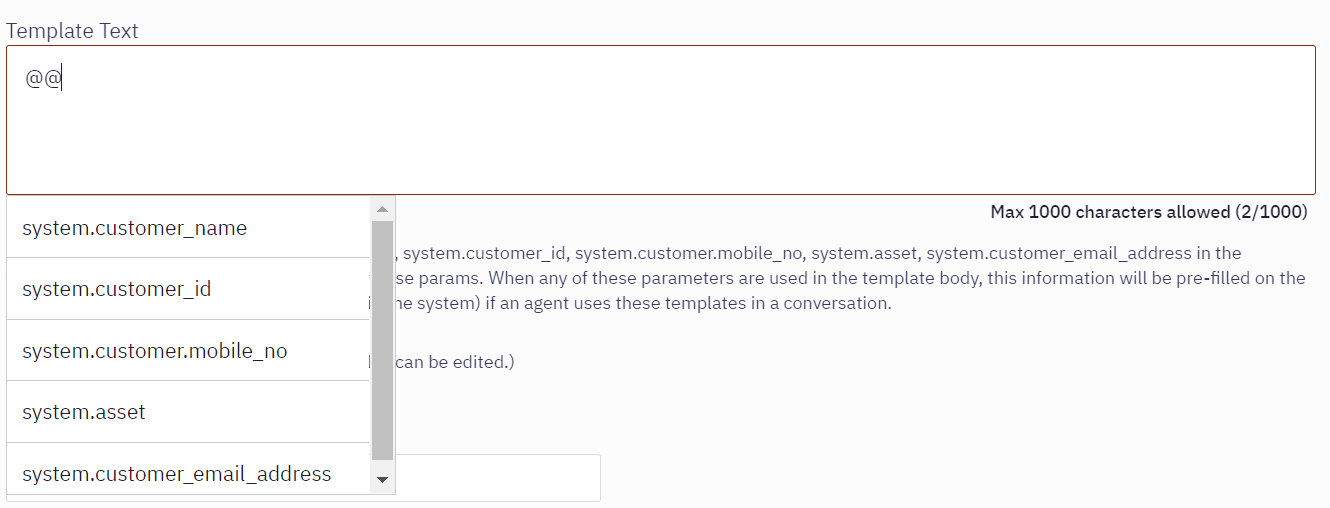

Note:
In the absence of relevant values for the configured parameters, the parameters will render in chevron braces and are yellow highlighted.
- You can even choose to enter the customized Template Text field.
- Select Lock Template checkbox to lock specific templates. When locked, only custom/dynamic fields can be edited by the agents. A lock icon is displayed corresponding to the template.
- To share the template with other teams, click in the Shared Across field and select the team from the list.
- Click Save Changes to create the template.
The success message appears on the screen.
Apple Business Chat Template
To create an Apple Business Chat template, follow these steps
- Click Apple Business Chat tab on the Add Template page.
The following screen appears.
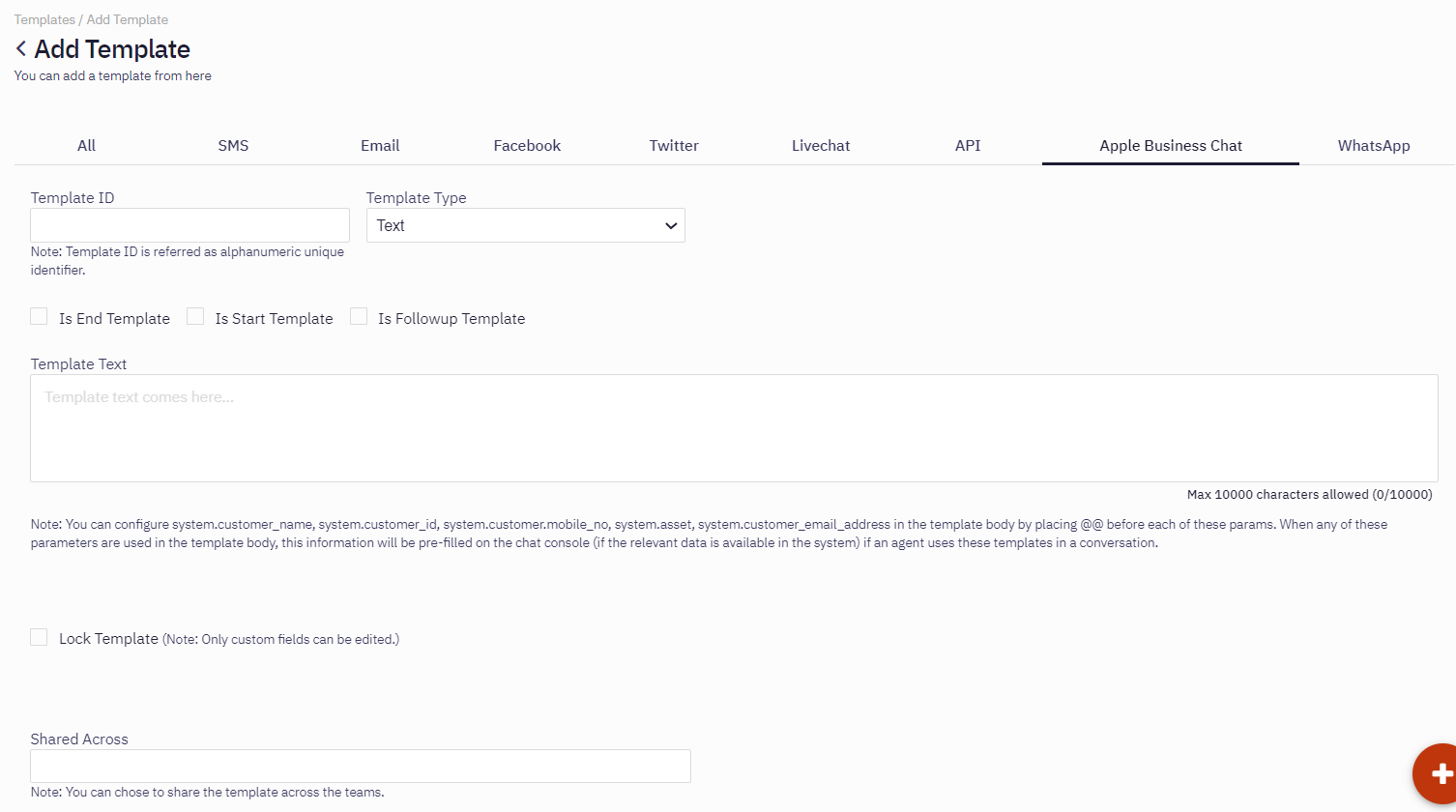
- Enter Template Name.
- Select template type - the template type can be Text, Text with Attachment, Time Picker, List Picker, and Rich Link.
- If template type as text is chosen, compose the Template Text. Maximum of 10000 characters can be entered in this filed.
- Select the Is end template checkbox to set the template as a closing message of the chat conversation.
For example: Thank you for your time. The agents will not expect any response to this message from the customer. - Select the Is start template checkbox to set the template as an opening message to initiate the chat conversation.
For example: Hello. - Select the Is Followup template checkbox to set the template as follow-up chat message of the previous chat conversation.
For example: In line with our earlier chat. - If Text with Attachment template type is chosen, the following options appear.
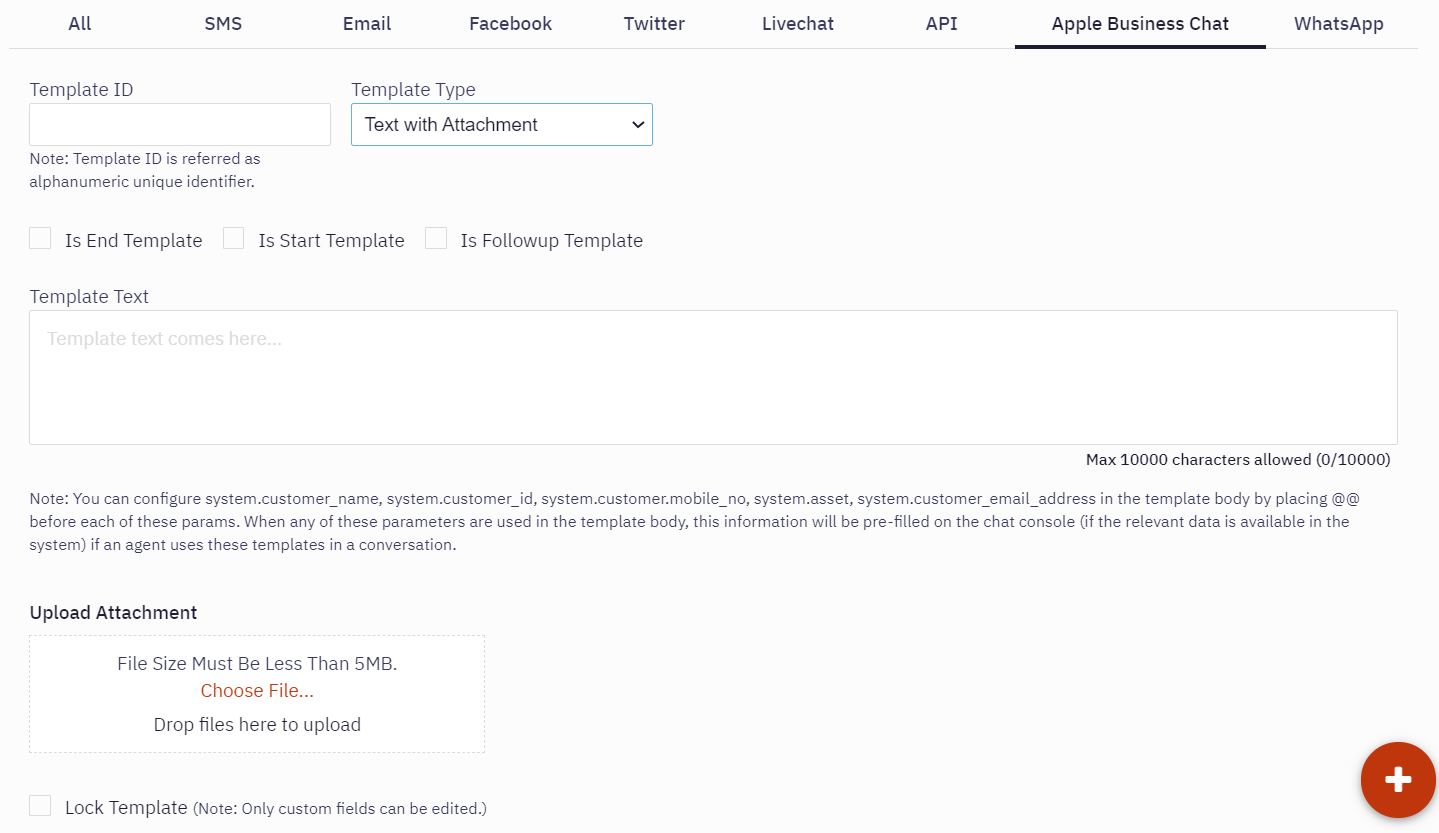
- Custom Fields: Enter custom/editable fields in the template body using chevron(<>) brackets. Custom fields are editable fields even in locked templates.
- System Parameters: Enter @@ to view the list of system parameters. You can select any of these parameters and compose the template text. When you include any of these parameters in the template text, the dynamic substitution of values occurs when an agent uses these templates in a conversation.
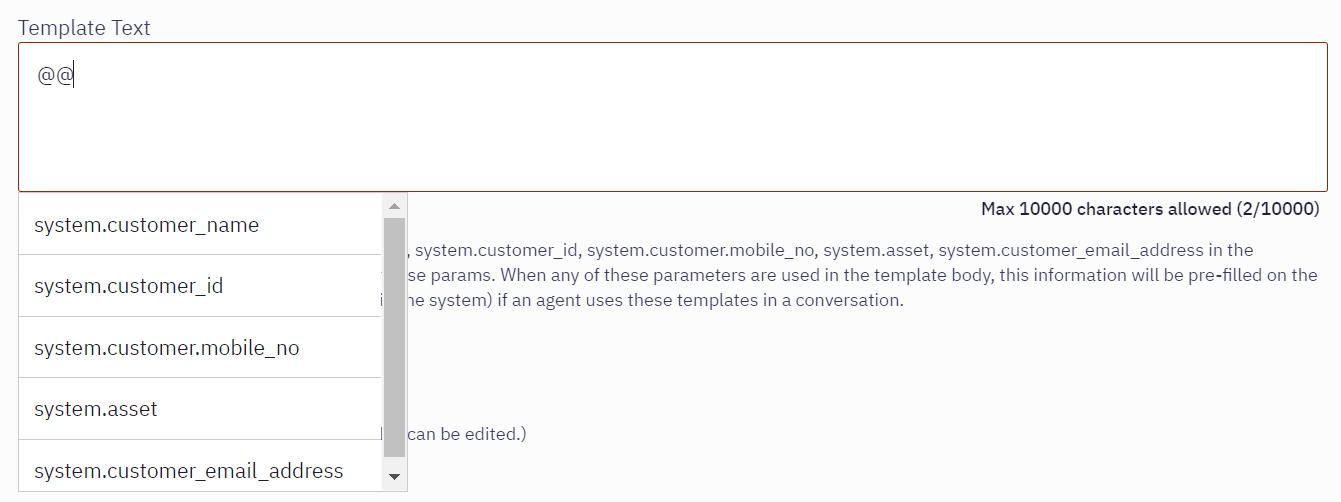

Note:
In the absence of relevant values for the configured parameters, the parameters will render in chevron braces and are yellow highlighted.
- You can also choose to enter the customized Template Text.
- Click Choose File/ Drop Files Here to upload an attachment. The maximum upload file limit is ≤ 5 MB.
- Select Lock Template checkbox to lock specific templates. When locked, only custom/dynamic fields can be edited by the agents. A lock icon is displayed corresponding to the template.
- If Time Picker template type is chosen, the following options appear.

Received Message: In this section, an admin can configure received messages.
15. Enter Title, Subtitle, and Click Choose File/ Drop files here to upload an attachment. The maximum upload file limit is ≤ 5 MB.
16. Here, admin can configure the uploaded image and view it in icon, small, and large sizes.
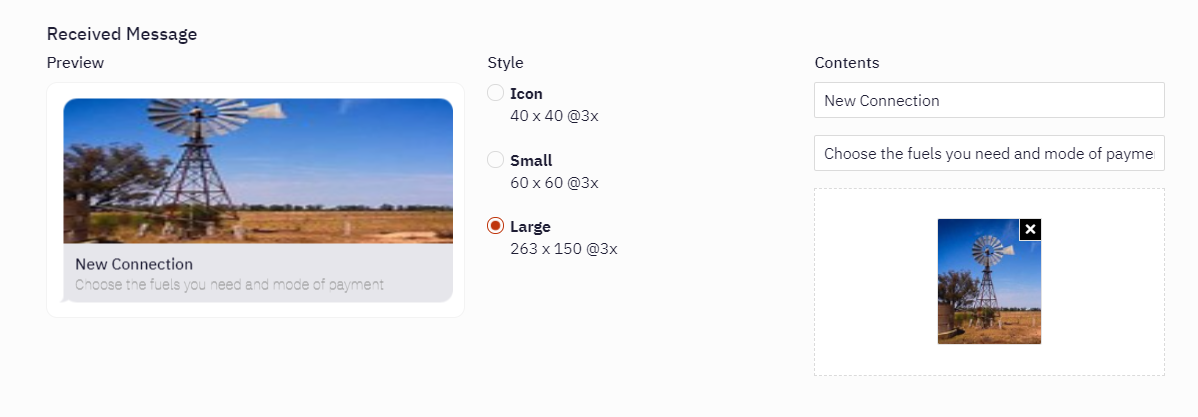
- Event Details: Toggle this field to pre-fill the details (manual agent intervention). When this field is enabled, the following options appear.

- Enter the Event Title,Location Details, and Show on Map details.
- Time Slots: Select the date, time, and duration from respective fields.

- Click Add icon to add more time slots.
Note:
The client admin can create maximum of Ten slots.

- Click - icon to delete a time slot.
Reply Message: In this section, a reply message can be configured. - Enter Title, Subtitle, and Click Choose File/ Drop Files Here to upload an attachment. The maximum upload file limit is ≤ 5 MB.

Here, admin can configure the uploaded image in icon, small, and large sizes.
23. If List Picker template type is chosen, the following options will appear.

- Received Message: In this section, received messages can be configured.
- Enter Title, Subtitle, and Click Choose File/ Drop files here to upload an attachment. The maximum upload file limit is ≤ 5 MB.
- Here, client admin can configure the uploaded image in icon, small, and large sizes.
- List Details: Enter Section Title.
- To have multiple sections for a section, check Allow Multiple Sections for Section option.
- Enter Item Name and Item Subtitle.
- To upload an image, click Drop Files Here to Upload option.
- To further add items to the list, click Add icon.
- To further add section, click Add Section.
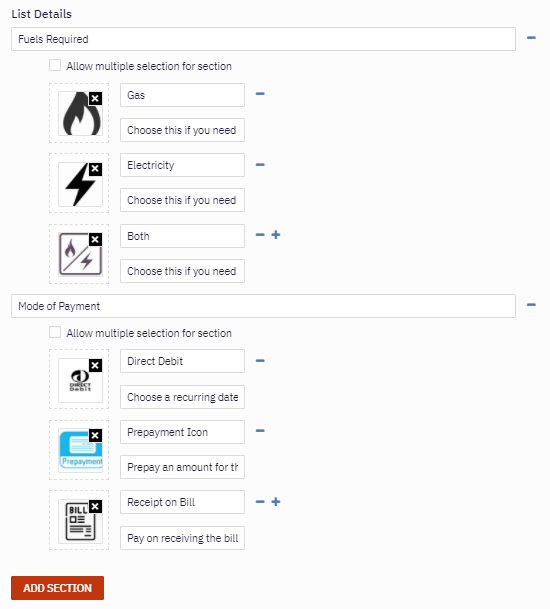
- To delete a section or a list item, click - icon next to it.
Reply Message: In this section, reply messages can be configured. - Enter Title, Subtitle, and Click Choose File/ Drop files here to upload an attachment. The maximum upload file limit is ≤ 5 MB.
Here, admin can configure the uploaded image in icon, small, and large sizes. - If Rich Link template type is chosen, the following options appear.
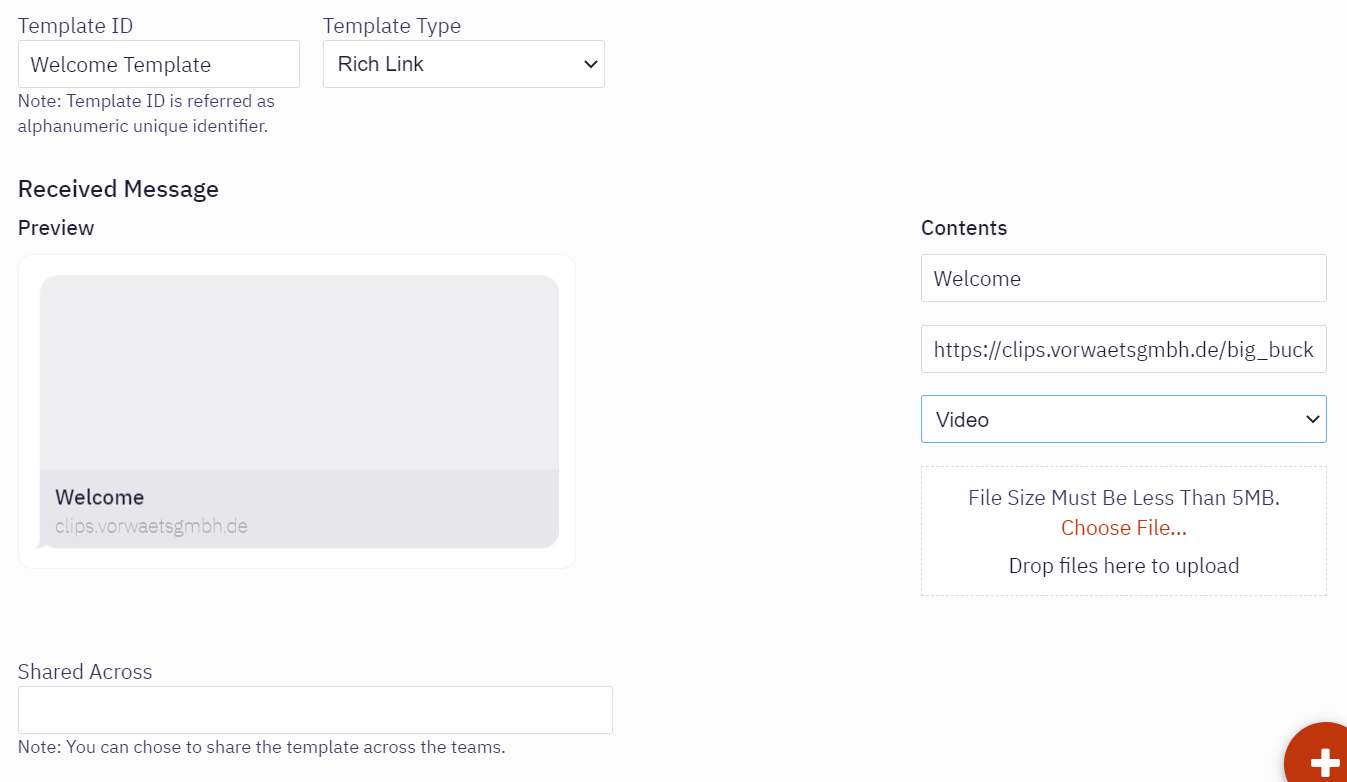
- Enter Title and URL.
- Select the file type (Image / Video) from the drop-down list. Click Choose File and upload Image/ Video.
Note:
The maximum upload file limit is ≤ 5 MB. Video file must be in MP4 format.
- To Share the Template with other teams, click and select the teams from the Shared Across list.
- Click Save Changes.
The success message appears on the screen. This template is listed in the chosen group.
WhatsApp Template
To create a WhatsApp template, follow these steps
- Click WhatsApp tab on the Add Template page.
The following screen appears.
- Enter Template Name.
- Select the Is End Template checkbox to set the template as a closing message of the chat conversation.
For example: Thank you for your time. The Agents will not expect any response to this message from the customer. - Select the Is Start Template checkbox to set the template as an opening message to initiate the chat conversation.
For example: Hello. - Select the Is Followup Template checkbox to set the template as follow-up chat message of the previous chat conversation.
For example: In line with our earlier chat. - Custom Fields: Enter custom/editable fields in the template body using chevron(<>) brackets. Custom fields are editable fields even in locked templates.
- System Parameters: Enter @@ to view the list of system parameters. You can select any of these parameters and compose the template text. When you include any of these parameters in the template text, the dynamic substitution of values occurs when an agent uses these templates in a conversation.
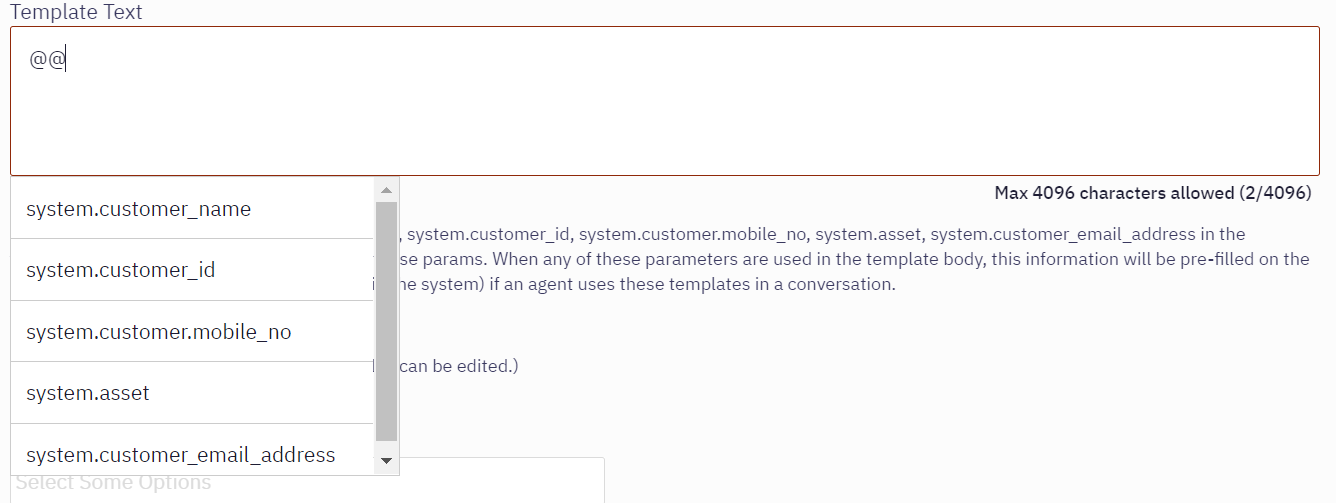

Note:
In the absence of relevant values for the configured parameters, the parameters will render in chevron braces and are yellow highlighted.
- To create a text template, select the Text radio button and enter the template text in the Template Text field. The maximum character limit allowed in the Template Text field is 4096 characters.
- To create an attachment template, select the Attachment radio button.
- Click Choose File/ Drop Files Here to upload an attachment. The maximum upload file limit is 64 MB.
Note:
To initiate a conversation with a customer, WhatsApp requires you to use a pre-approved WhatsApp Business (WAB) registered message templates.
- To create WAB registered message, select the WAB registered message radio button. The following options appear on the screen:
- Select a category from the Category drop-down list.
- Select a language from the Language drop-down list.
- Select the WABA name from the WABA Name(ID) drop-down list. These WABA names are configured at the asset level.
- To include a header for a template, select the Text header type from the Header drop-down list. The maximum character limit for the header text field is 60 characters.
- To add a custom variable in the header text, click Add Variable above the Header Text field. A custom variable is added in the Header field. Enter the required custom variable.
- Enter the template text in the Message Body field. The maximum allowable character limit in this field is 1024 characters. You can apply following rich formatting styles to the Message Body text:
- Bold
- Italics
- Underline
- Strikethrough
You can enter both system and custom parameters in the Message Body field.
- Click Add Variable, to add a custom variable.
- Enter @@ in the Message Body field to view a list of system variables. Select a required variable.
Note
When you include any of these parameters in the template text, the dynamic substitution of values occurs when an agent uses these templates in a conversation.
- The footer is a text field. To add a footer to the template, enter the footer text in the Footer field. The maximum allowable character limit for footer is 60 characters.
- To share a template with other teams, click in the Shared Across field and select the teams from the configured teams list.
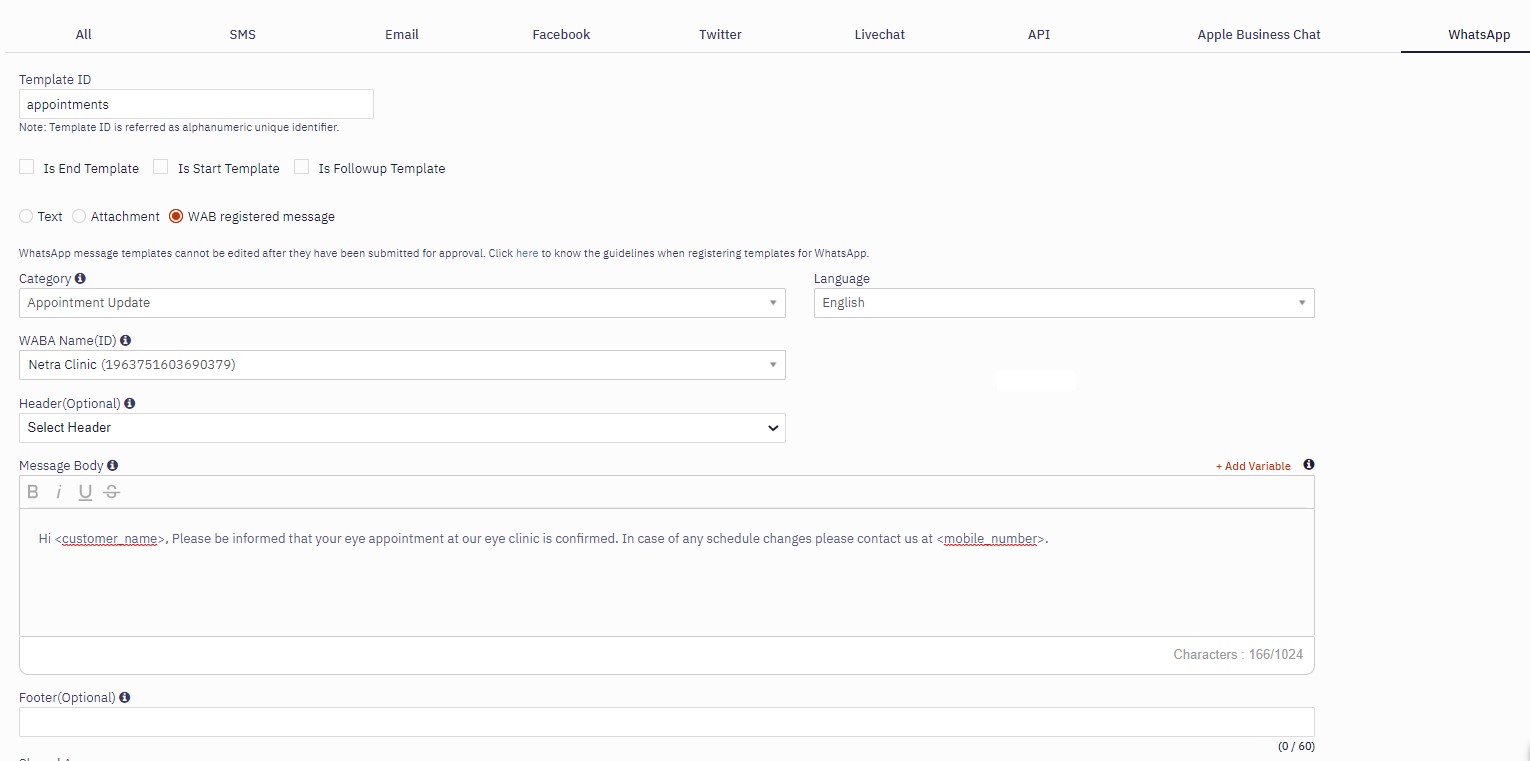
- Click Save Changes.
To view the approved templates on the chat console, follow these steps:
- Navigate to the Templates (Client Admin Console>Assets) tab.
- Navigate to the required group and click the Edit icon in the Actions column of a template.
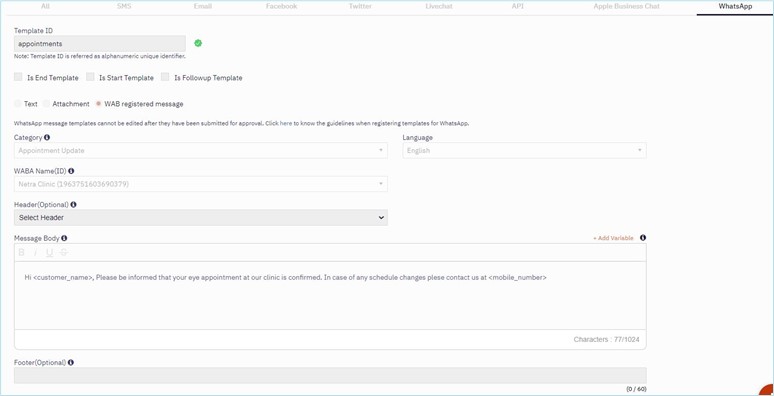
The template is approved if you observe a green checkmark beside the template name on the Edit template screen. You can even mouse hover on the green checkmark to view the status. You can view only the approved WAB templates on the chat console.
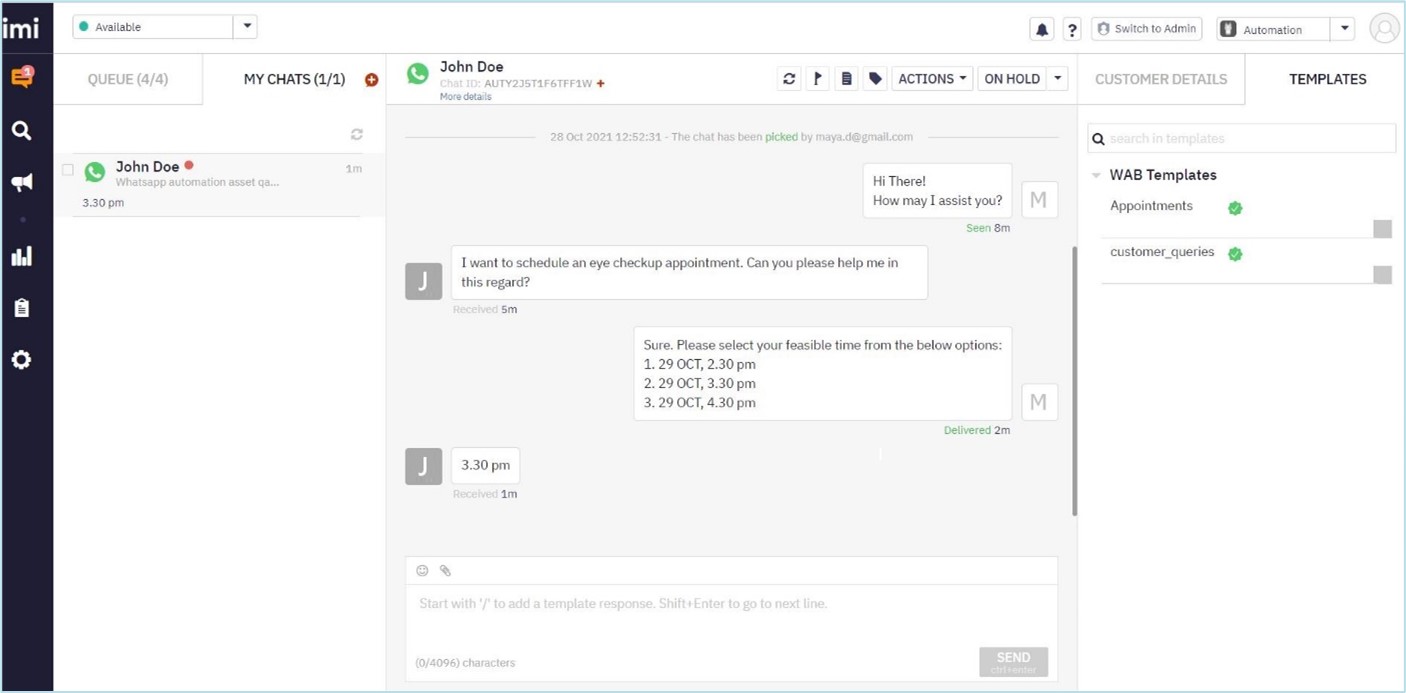
Note:
- You can create a message template in one language at a time. WAB registered templates do not support multi-language templates. So, to create templates in multiple languages, you need to create a separate template for each language.
- You cannot edit the WhatsApp templates once they are submitted for approval, but you can edit the shared across teams.
- You can delete a message template, but WhatsApp does not allow you to create a template with the same name for four weeks.
For more information on how to Add and Configure Mobile Numbers in Facebook WhatsApp Manager, click on the below link
https://developers.facebook.com/docs/whatsapp/getting-started
Edit Template
To edit a template follow these steps:
- Click Edit icon adjacent to the template name.

The following screen appears.
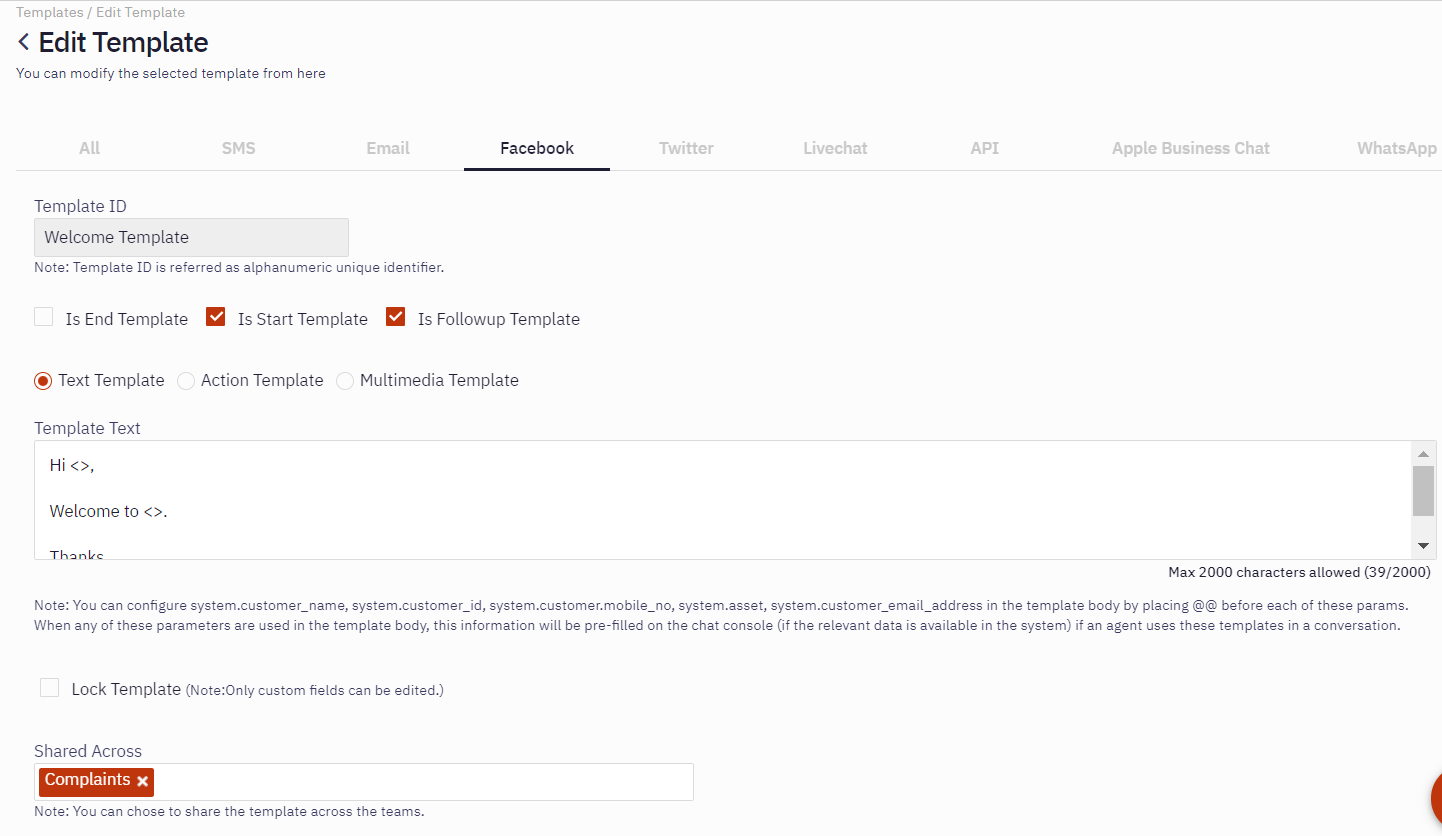
- Make the required changes to the template, and click Save Changes.
The success message appears on the screen.
Delete Template
To delete a template follow these steps:
- Click Delete icon corresponding to the template name.
A confirmation popup window appears.

- Click OK to delete the template.
The success message appears on the screen.
Note:
Client Admins can reuse the deleted template names for new templates. However, Webex Engage maintains old templates details for reporting purposes. So, a soft delete action is performed while deleting the templates. The deleted template names are reflected in Template Usage Summary and Customers Response Time reports in the following format: <{{Template}} –
[DELETEDON{{ts}}]>Example: Template Name - [DELETED_ON_2019-02-01T08:00:00Z].
Updated almost 3 years ago
